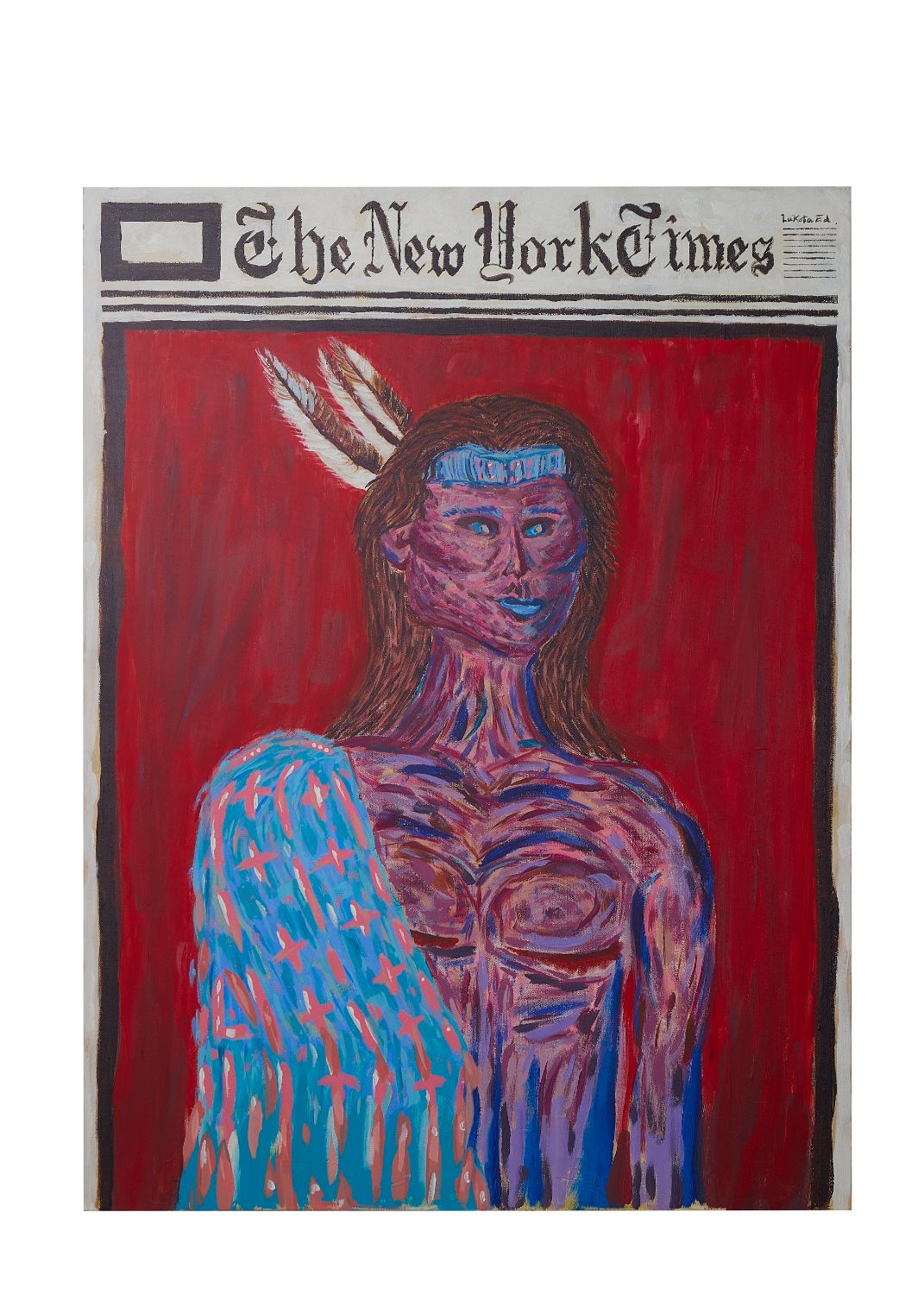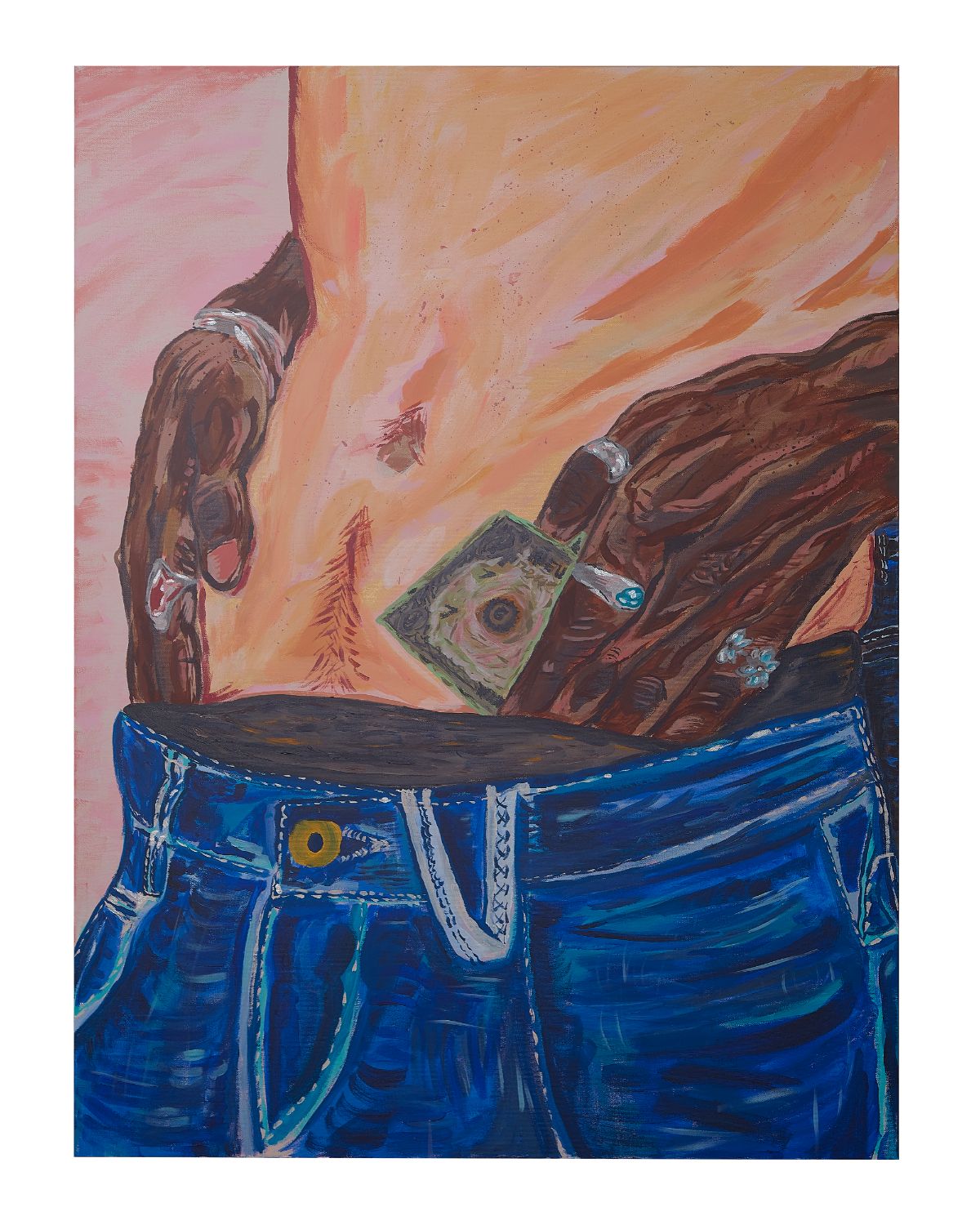
The Worlds We Live In
Published July 31st, 2025 by Cory Eull
Will Raymond on shared imagination and the power of representation
Banner image: Will Raymond, The Worlds We Live In. Photos courtesy Alexander Just, Toast Studios, St. Paul
I hesitate using the word imagination. Imagination makes me think of girlhood and unicorns and the will to grow wings, surely something more feeble and farfetched than what a future of liberation is built upon. But as my thoughts swim around each of the six pieces featured in Will Raymond’s first solo exhibition, The Worlds We Live In, I remember that imagination doesn’t passively sit in the body, like fantasy, but rather viscerally grabs hold, like belief. Using traces of American iconography to highlight new, underrepresented, and sometimes controversial icons, self-taught painter Will Raymond centers the complexity of identity, and grounds it as a source to propel notions of “visibility, resistance, and belonging."
The body of work started with The Worlds We Live In, a flag made out of four generations worth of denim. Collecting the denim from his family, Raymond notes, “We’re all Native, so it's really paying homage to the labor movement…America was built off of the middle class and the working class.” An image of the flag is what initially piqued my interest in Raymond’s show. The denim is such a strikingly everyday material and before it became a fashion staple, signified durability, affordability, and implied manual labor. Seven different strips of waistline make up the flag, peppered with belt loops. The cuff of a pant leg has 50 white painted stars and is set into the top left corner of the textile. Who wore these jeans? Were they farm laborers? Railroad workers? This piece brings an intimate curiosity to the viewer’s eye, making them forget for a few minutes that it’s a variation of an American flag in front of them.
There’s another flag in the show: Our Mirror, this one representing five different cultures through patterned cultural material — Bengali, Hmong, Indigenous Mexican, Somali, and the artist’s maternal tribe of Anishinaabe. The assemblage is rich with color.
“All these fabrics are sourced from four different women in my life that are influential, but also important to me. I wanted to make something that weaved together all of our cultures, took a piss out of the flag, but also represents that we do have ownership of this place that we live in,” they say. Raymond points to one of the rectangular bands of fabric positioned within the flag, saying that friend and Minneapolis City Council member, Aurin Chowdhury, had offered it to him.
The remainder of Raymond’s pieces are paintings, and each taps into the research question he asked himself: “Who are some iconic American figures that I want to actually make portraits of?” One of these is a larger-than-life portrait of Angela Davis, titled Angela's Dream.

Will Raymond with Angela's Dream.
“I wanted to put a radical thought leader, whether you think she’s radical or not…And I wanted to make people imagine who she is,” they say. Despite the ways Raymond says Davis has been misunderstood or controversial in her philosophies and ideologies, he says he “wanted to respect her and respect [his] friends who have that sort of idealism.” There is a layer of abstraction underneath the portrait of Davis, the canvas consumed by yellow, red, blue, and pink mark-making. The artist mentions this abstraction, reflecting how outlandish idealism can come across to mainstream culture. Additionally, the swirling, whirling pop of color combined with Davis’ forward gaze gives the piece a visionary tone.
In another of the four paintings, titled What Narrative?.., Raymond brings into existence the identities that are commonly absent in conventional media. Painting a transgender, Native man on the cover of The New York Times, Raymond quite literally paints a nuanced identity into the realm of representation.
 Will Raymond, What Narrative?...
Will Raymond, What Narrative?...
“The civil rights lens of the American psyche has only been able to comprehend black and white issues, so this specifically, for me as a Native person, was important to make,” says Raymond, who also identifies as Two Spirit. “People haven’t seen an image like this and yet we’re able to tangibly look at it and understand where it comes from.” The man on the cover bears top-surgery scars, which seep like badges of honor, whilst red gems adorn the scars and lead the eye to the chest. A figment of Raymond’s ideation, the person looks primal, and almost fantastically creature-like with piercingly blue lips, eyes, and brows. Otherworldly, but just within reach, the man has a powerful presence. And Raymond is right, I haven’t seen anyone like him.
In the piece QUEER, the viewer is a voyeur of a kind of intimacy, without the painting directly showing two people kissing. It is more of an accidental closeness, like witnessing two strangers on the other side of a crowd embracing one another in the corner of the bar.
 Will Raymond, QUEER
Will Raymond, QUEER
“We’re now seeing the rollback of all the protections that we’ve had consistently for gay civil rights. So I wanted to show what I think is very casual,” they say. Again, there is a power in that casual—risqué to some—but seemingly harmless moment.
“OK, I’m going to quiz you,” Raymond says as he carries another large canvas into his combined living room/painting studio, where I'm perched on a stool with my notebook. “Do you know who this is?” Raymond had painted and screenprinted a Warhol-style portrait of Marsha P. Johnson, who was heavily involved in the Stonewall uprising, and considered as one of those who started the modern day gay liberation movement. The piece is titled Herstory. Like in the Davis painting, Raymond had covered the canvas in abstract shapes and hues, then screenprinted Johnson’s face onto the canvas.
 Will Raymond, Herstory
Will Raymond, Herstory
These figureheads at the center of the show almost feel like guardians over the viewer. Inspired by iconic portraits, Raymond says, “Everybody has their version of what to fight for." I respect and relate to the scrappiness required of a younger artist like them. Young artists are forced to be resourceful with exhibiting. Even at A-Mill Artist Lofts, artists are booked out two years. Raymond managed to secure the space for a one-night-only show, bookended by other artists’ exhibitions.
"If you have a free space, you use it,” says Raymond. They say the show is “a love letter to all my friends." They're hoping to create a “palatable,” accessible opportunity to look at art, and for his Black, Native queer peers to see themselves within it, and feel celebrated in their realities. ◼︎
See Will Raymond's one-night-only show, The Worlds We Live In, at the A-Mill Artist's Lofts on August 1. Learn more about Raymond's work @willslayy.
We can't do it without you.
Help keep independent arts journalism alive in the Twin Cities.